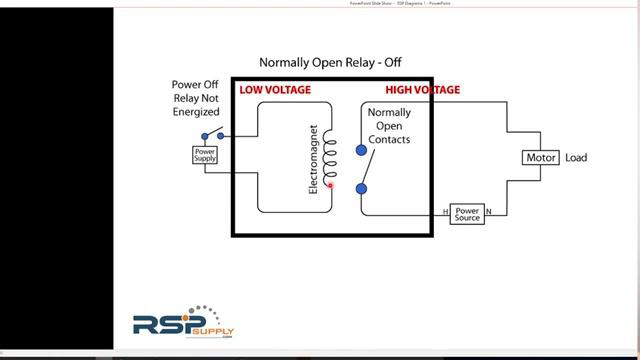What_is_a_Relay__How_it_Works.pdf
Relay Basics: What a relay is and how they work
What is a Relay?
- A Relay is an electrically operated switch
- Used for many different applications
- Allows for a low voltage circuit to operate a higher voltage circuit
- Can be used to monitor the status of electrical equipment (such as a motor)
What parts make up a relay?
- Coil (a tightly wound spool of wire). When current is applied, it will act as an electromagnet
- Contact (a lever that can be opened and closed). Is acted upon by the coil
- Terminals (points where wires can be connected to the relay)
How does it work?
- When current is applied to the coil it will pull the contact (which is normally open) closed allowing current to pass through the contact side of the relay
- Some relays have multiple options on the contact side of the relay. They can have both a normally open (NO), or normally closed (NC) set of contacts. When both options are available on one relay, this is referred to as a double throw relay
Find a selection of Relays at RSP Supply including:
Transcript:
[0m:4s] Hi I'm Josh Bloom, welcome to another video in the RSP Supply education series. Today we're going to be talking about relays, what are they, and how do they work. A relay is simply an electrical switch like you might find in your home. Instead of being operated by someone to turn it on or off, it is simply operated by another electrical circuit. So, essentially a relay is an electrically operated switch. So why do we use relays? We typically see relays used when we need to control a switch that has high voltage or high current passing through it.
[0m:37s] Operating these types of switches manually can be dangerous, inefficient, and impractical. By using relays, we can greatly increase the operational safety of electrical circuits.
[0m:47s] It also allows us to use smaller, safer, less expensive electrical devices to switch and control electrical circuits. Using relays also allows us to control several devices on a single switch as opposed to using several different bulky switches. Relays can also be combined with timers and logic circuits to allow for electrical automation. So now, where are we going to find relays used? Relays are used everywhere.
[1m:13s] Relays are found in most electrical devices that operate things like a motor or a light or several other electrical devices. They are also very common in cars. With a 12 Volt power supply coming from the battery in our car, most of the electrical devices in the car require a large amount of current running through them. Which is a perfect use case for relays. In industrial applications, they are commonly used in control panels for various tasks such as monitoring power or controlling a motor or valve or other electrical devices in automation. So, how do relays work? Let's first look at some of the components within the relay that are critical to its operation. The first thing we're going to look at is the coil or the electromagnet. When power is passed through this coil, it creates a magnetic field.

[2m:0s] The next thing we're going to look at is the armature which can be seen right here, which is acted upon when the coil is energized.
[2m:7s] Lastly, we'll look at the contacts which are here and here.
[2m:10s] When those contacts touch one another, they allow power to pass through them.
[2m:14s] So, a relay consists of two separate circuits that work together to open or close a switch. I have one circuit here and I have another circuit here. The first circuit drives the coil or electromagnet. The electricity passes to the coil and it creates a magnetic field. The second circuit contains a set of contacts and a separate power source.
[2m:35s] This circuit is what provides power to the electrical load.
[2m:38s] When electricity passes through the coil
[2m:41s] it creates a magnetic field.
[2m:43s] This magnetic field pulls the contact from the other circuit closed which will allow current to pass through the contacts, therefore allowing the load to become energized. When the coil is de-energized, the magnetic field is gone which allows the contact to be pushed back into its original state, de-energizing the load side of the circuit. So, for example here, I have a 24 Volt DC relay which are commonly used in industrial applications. What this allows us to do is send a low voltage 24 Volt DC signal to energize the coil, allowing us to switch a much higher voltage motor or fan or other electrical device. So, in essence, we have the ability to control a high voltage electrical device in a safe low voltage environment.
[3m:27s] For a full line of relays or thousands of other products, please go to our website. For more information or other educational videos, go to RSPSupply.com, the Internet's top source for industrial hardware. Also, don't forget: like and subscribe.




